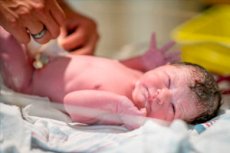
一项新的研究证实,对于无并发症的孕妇来说,水中分娩与产前离开水一样安全。这项题为“产时水浴后水中或水外阴道分娩的产妇和新生儿结局:POOL队列研究”的研究发表在《BJOG:国际妇产科杂志》上。
研究人员研究了超过8.7万名无并发症孕妇的分娩经历,她们在分娩过程中采用水浴来缓解疼痛和舒适感。这项研究旨在探究在水中分娩是否与分娩前离开水面一样安全。
研究团队负责人、卡迪夫大学临床助产学教授朱莉娅·桑德斯表示:“英国每年约有6万名妇女使用分娩池或分娩浴盆来缓解分娩疼痛,但一些助产士和医生担心水中分娩可能带来额外的风险。有报道称,水中分娩后婴儿可能患重病甚至死亡,产妇也更容易出现严重撕裂或失血过多。因此,需要开展一项大规模研究来探究英国水中分娩的安全性。”
临床妇产科教授朱莉娅·桑德斯表示:“我们想确定由 NHS 助产士进行的水中分娩对于产妇和婴儿来说是否与水外分娩一样安全,并且并发症风险较低。”
由卡迪夫大学公共卫生学院和临床试验研究中心牵头的POOL研究,调查了2015年至2022年间,英格兰和威尔士26个NHS信托机构中87,040名使用水池分娩的女性的NHS记录。研究人员分析了产妇严重撕裂伤的发生率、新生儿在新生儿病房需要抗生素或呼吸辅助的频率,以及婴儿死亡率。
“我们研究的主要目的是回答使用分娩池或分娩盆的女性在分娩过程中经常提出的一个问题——产科医生经常询问母亲,如果分娩过程顺利的话,她们是否应该留在水中分娩。
“在我们研究的女性中,有些人会走出泳池寻求额外的医疗护理或缓解疼痛。大多数走出泳池寻求额外医疗护理的女性都是初产妇——三分之一的初产妇走出泳池寻求额外的医疗护理,而已经生育过的女性中,只有二十分之一会走出泳池寻求额外的医疗护理,”桑德斯说。
总体而言,研究人员发现,在分娩期间使用游泳池的妇女中,约有一半是在水中分娩的。
研究人员发现,大约每20名初产妇中就有1名,每100名第二次、第三次或第四次分娩的产妇中就有1名出现严重的胎盘撕裂。他们还发现,大约每100名婴儿中就有3名在新生儿病房出生后需要抗生素治疗或呼吸辅助,婴儿死亡的情况很少见。但水中分娩和水外分娩的这些并发症及其他并发症的发生率相似。
他们的数据显示,剖腹产率很低,初产妇剖腹产率不到 6%,二产、三产或四产剖腹产率不到 1%。
“鉴于 10% 的女性在分娩时采用水浸疗法来缓解疼痛,这项研究的结果将影响英国每年数千名女性,以及世界各地更多在分娩时采用水浸疗法的女性,”彼得·布罗克赫斯特教授说。
伦敦切尔西和威斯敏斯特医院基金会新生儿科顾问克里斯·盖尔教授表示:“许多儿科医生和新生儿科医生担心水中分娩可能会给婴儿带来额外的风险,但研究发现强有力的证据表明,对于妊娠无并发症的女性来说,情况并非如此。”
研究小组的家长代表、前产前教师 Rachel Placzynski 表示:“看到助产士注意到分娩过程中的潜在问题并鼓励这些妇女离开水池,以便母亲和她们的婴儿能够得到适当的监测和护理,我们也感到欣慰。”
“我们的研究已科学证实,水中分娩不会增加母亲和婴儿的风险。通过分析英格兰和威尔士超过87,000例分娩的NHS数据,我们能够提供相关信息,帮助母亲和助产士在分娩过程中做出决策。”桑德斯教授补充道。

